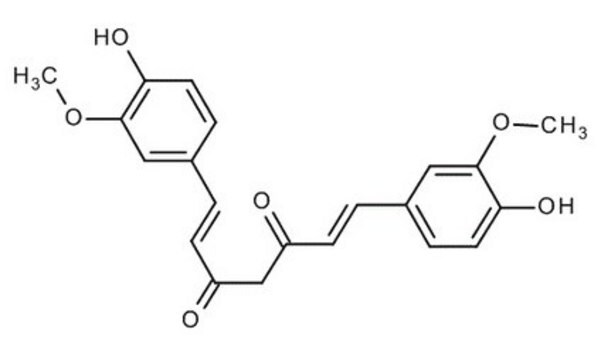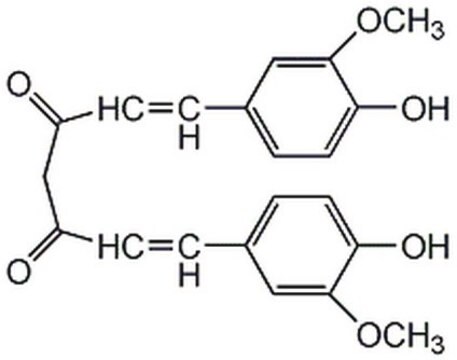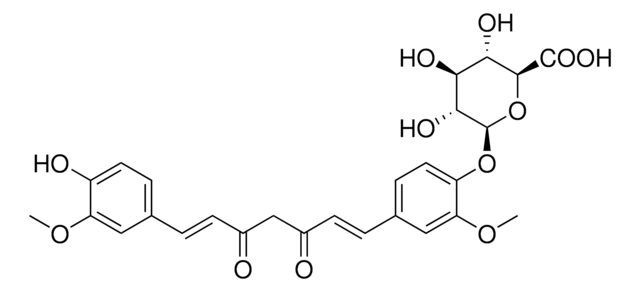C1386
Curcumin
from Curcuma longa (Turmeric), powder
Synonyme(s) :
(E,E)-1,7-bis(4-Hydroxy-3-methoxyphenyl)-1,6-heptadiene-3,5-dione, Diferuloylmethane, Diferulylmethane, Natural Yellow 3
About This Item
Produits recommandés
Source biologique
Curcuma longa (Turmeric)
Densité de vapeur
13 (vs air)
Forme
powder
Concentration
≥65% (HPLC)
Pf
175 °C
Solubilité
ethanol: 10 mg/mL
DMSO: >11 mg/mL (lit.)(lit.)
0.5 M NaOH: soluble (then immediately dilute in PBS [lit.])(lit.)
Application(s)
metabolomics
vitamins, nutraceuticals, and natural products
Température de stockage
−20°C
Chaîne SMILES
COc1cc(\C=C\C(=O)CC(=O)\C=C\c2ccc(O)c(OC)c2)ccc1O
InChI
1S/C21H20O6/c1-26-20-11-14(5-9-18(20)24)3-7-16(22)13-17(23)8-4-15-6-10-19(25)21(12-15)27-2/h3-12,24-25H,13H2,1-2H3/b7-3+,8-4+
Clé InChI
VFLDPWHFBUODDF-FCXRPNKRSA-N
Informations sur le gène
human ... APP(351) , CYP1A2(1544)
Vous recherchez des produits similaires ? Visite Guide de comparaison des produits
Description générale
Application
- to study its effect on the consequences and mechanism involved in the suppression of human homeobox gene NKX3.1 in the prostate cancer cell LNCaP
- to examine its effect on stress in pigs by having an inhibitory impact on the serum cortisol concentration, hippocampal nitric oxide production, and brain-derived neurotrophic factor expression
- to study its effect as a dietary supplement on the growth, immunity, antioxidant activity, and disease resistance in Oreochromis niloticus
- to analyze its protective effect on the organotypic hippocampal slice cultures against the synaptic toxicity caused by amyloid beta peptides (Aβ1–42)
- to examine the possibility of its non-toxic concentrations to decrease the inflammation caused by interleukin-1beta (IL-1β) in cartilage explant cultures
- to study its protective impact against intestinal ischemia-reperfusion injury in rats
- to measure its antibacterial activity in vitro
- to determine its preventative effects for Alzheimer′s disease (AD) in mice
- as a bifunctional agent for generation and validation of the erythroid 2-related factor 2 (Nrf2) reporter system
- to study its in vitro inhibitory effects on human liver glucuronidation activity
- to evaluate its effects on Parkinson′s disease (PD)-like phenotypes
Actions biochimiques/physiologiques
Caractéristiques et avantages
Code de la classe de stockage
11 - Combustible Solids
Classe de danger pour l'eau (WGK)
WGK 3
Point d'éclair (°F)
Not applicable
Point d'éclair (°C)
Not applicable
Faites votre choix parmi les versions les plus récentes :
Déjà en possession de ce produit ?
Retrouvez la documentation relative aux produits que vous avez récemment achetés dans la Bibliothèque de documents.
Les clients ont également consulté
Articles
Epigenetic modifications are thought to occur through two key interconnected processes—DNA methylation and the covalent modification of histones.
Contenu apparenté
DISCOVER Bioactive Small Molecules for Nitric Oxide & Cell Stress Research
Notre équipe de scientifiques dispose d'une expérience dans tous les secteurs de la recherche, notamment en sciences de la vie, science des matériaux, synthèse chimique, chromatographie, analyse et dans de nombreux autres domaines..
Contacter notre Service technique









